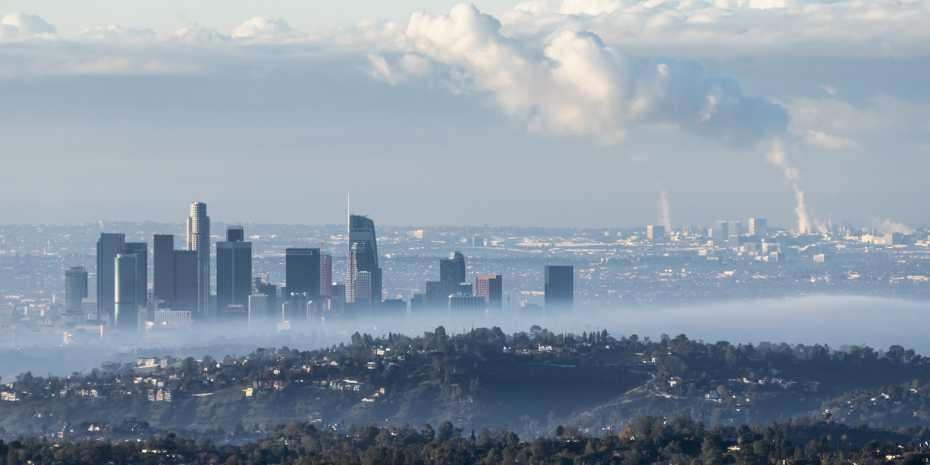Feb 19 2021
Back in the late 1980s and 1990s, scientists from ETH Zurich had detected the initial signs that the amount of solar light reaching the surface of the Earth had been progressively declining since the 1950s.
 Haze over Los Angeles: Aerosols dim the incoming sunlight. (Image Credit: Adobe Stock.
Haze over Los Angeles: Aerosols dim the incoming sunlight. (Image Credit: Adobe Stock.
Such a phenomenon was called 'global dimming' but a reversal in this trend became apparent only in the late 1980s. At several locations, the atmosphere brightened once again and solar radiation on the Earth's surface also increased.
In previous studies, we showed that the amount of sunlight that reaches the Earth’s surface is not constant over many decades but instead varies substantially—a phenomenon known as global dimming and brightening.
Martin Wild, Professor, Institute for Atmospheric and Climate Science, ETH Zurich
Natural Variations or Air Pollution?
However, not much is known about the reasons behind these changes, which have been witnessed for many years. One specifically debatable point is whether they are the outcome of natural changes in the climate system, or whether the variations are induced by air pollution, with aerosols obstructing the solar light.
Many researchers believed that cloud cover could have altered over the years and probably absorbed the solar radiations more efficiently during the dimming stage rather than during the brightening stage.
This spurred Wild and collaborators from other research institutes to study the measurements obtained from 1947 to 2017 in the Potsdam radiation time series, which is popular among climate scientists. The Potsdam radiation time series provides one of the longest, continuous, and most uniform measurements of the Sun’s rays on the surface of the Earth.
Dimming Also Occurred in Cloud-Free Conditions
In the latest research work, the team was able to demonstrate that these changes are not caused by natural variations in the cloud cover, but instead, they are produced by varying aerosols from human activity. The study was published in the Geophysical Research Letters journal.
In our analysis, we filtered out the effects of cloud cover to see whether these long-term fluctuations in solar radiation also occurred in cloud-free conditions.
Martin Wild, Professor, Institute for Atmospheric and Climate Science, ETH Zurich
As it turned out, the decade-old variations in the solar light reaching the surface of the Earth were discernible even during clear skies. The investigators observed that aerosols that enter the atmosphere as a result of air pollution contribute significantly to global dimming and brightening.
“Although we’d already assumed as much, we’d been unable to prove it directly until now,” Wild added.
Brightening After Economic Collapse
The fact that the shift from global dimming to brightening matched with the economic collapse of the former communist nations—which occurred in the late 1980s—supports the disagreement that such changes are caused by human activity.
Around this period, several western industrialized countries had introduced stringent regulations on air pollution, which considerably enhanced air quality and enabled the transfer of solar radiations through the air. And last but not the least, the air was recovering from the volcanic explosion of Mount Pinatubo, which had released huge amounts of aerosols into the atmosphere in 1991.
In a previous study, Wild and his collaborators had already ruled out variations in solar activity.
The sun itself had only an infinitesimal, negligible effect, which in no way accounts for the magnitude of the intensity changes that had been observed over the years at the surface.
Martin Wild, Professor, Institute for Atmospheric and Climate Science, ETH Zurich
Dimming Reduced Evaporation and Precipitation
A major parameter for climate concerns is surface solar radiation. This parameter not only controls the temperature but also has an underlying effect on the water cycle by governing evaporation, which, consequently, governs the formation of clouds and impacts precipitation. At the time of the global dimming, less amount of water evaporated from the surface of the Earth, causing precipitation to reduce across the world.
The Sun’s rays also have an impact on the cryosphere, that is, ice, snow, and glaciers. According to Wild, “ “Glacial retreat accelerated when the atmosphere began brightening again,” and he further added that, “It’s also becoming increasingly important for the solar industry to gain a better understanding of these fluctuations when it comes to planning new facilities.”
The Deutscher Wetterdienst—the National Meteorological Service in Germany—manages an observatory located in Potsdam. This observatory has been quantifying the Sun’s radiation since 1937 which means that it has one of the longest radiation time series in the world.
“I’m extremely grateful to have access to decades’ worth of data; after all, it is only thanks to measurement series such as this that we’re able to record and show changes in our environment and climate,” stated Wild and further added that this makes it crucial to support the monitoring networks worldwide for extended periods of time. Undeniably, this job is not specifically remarkable, rendering it hard to get funding support.
“But if we want to understand climate change and clarify the impact of human activities, we need time series that go back far enough,” Wild concluded.
As such, ETH Zurich preserves the Global Energy Balance Archive (GEBA)—an unmatched database of surface energy fluxes across the world.
Journal Reference:
Wild, M., et al. (2021). Evidence for Clear‐sky Dimming and Brightening in Central Europe. Geophysical Research Letters. doi.org/10.1029/2020GL092216.